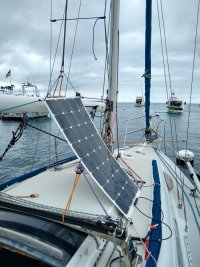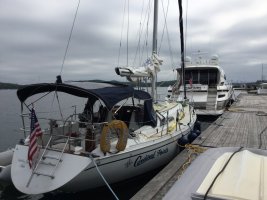Bolo
Contributing Partner
I know, the title of the posting, "Solar Panel Sailing Lifestyle Choices", sounds like something you'd see in social media rather than a sailing web site but the title sort of fits my recent thoughts about solar panel use on a sailboat. More then 90% of my sailing take place on the Chesapeake Bay with the occasional sailing done on someone else's boat when I visit the Tampa Bay area. For the most part my wife and I and the occasional guests leave from our marina, where we've been plugged into shore power, for a day sail. Other times my "1st mate" and I sail to other marinas on the bay and when there plug into their shore power. We have also sailed to places where we anchor or find a mooring ball and then, of course, there is no shore power. We want to do more of the latter, anchor more rather then find a marina and to that end we recently purchased a new inflatable dinghy and Torqeedo to get us ashore. In the past being at anchor for more than two days in a row meant starting the engine to charge the batteries which is not the best way of charging, IMO, and it's noisy. Something else you don't want in a peaceful anchorage. We even tried using a Honda generator (that I purchased for my business) a few times but found even that noise level objectionable along with storing the generator and fuel.
Solar panels are the next logical step but they to present their own problems. First off, on a boat the size of an E32-3 setting up a permanent installation is (again IMO) difficult and can ruin the look of the boat. Remember, I'm not doing ocean cruising where I'd be off grid for weeks at a time, I just need something to help keep the lights on at night, keep the beer cool in the frig and help out with the charging. It's all a matter of how and where you sail. So in considering my situation, which I think is close to describing the majority of not only Ericson sailors but others, I think the best solar option would be a "temporary and portable" solar panel system. The one I've been looking at is the 100 Watt Xantrex Solar Portable Flex Kit. Here a link for them on the Defender web site: https://www.defender.com/search.html?q=xantrex portable flexible solar panel kit
I'm not expecting the 100 watt panel (rated as such but never really deliver that much) will not meet all of my electrical needs but considering the kind of "sailing lifestyle" I lead I think that a portable solar panel would work well. When in use at anchor I could lay the unfolded panel on the deck, selecting the best full sun position or even lay it on top of my bimini. It would work there even under sail because the panels are flexible and have grommets that can be used to tie them to the bimini frame. I could even purchase a second panel to help out. When not needed the panels fold up to a size of 17.7 x 20.5 x .8 inches making them very storable. The biggest electrical load is my refrigerator and under sail the Raymarine auto helm only when it's being used. So I'm considering the purchase to help with the recharging not to replace the usual methods of shore power and engine generator.
Anyone ever use portable solar panels on board or consider using them? Your thoughts would be helpful and I think interesting to this conversation. Thanks.
Solar panels are the next logical step but they to present their own problems. First off, on a boat the size of an E32-3 setting up a permanent installation is (again IMO) difficult and can ruin the look of the boat. Remember, I'm not doing ocean cruising where I'd be off grid for weeks at a time, I just need something to help keep the lights on at night, keep the beer cool in the frig and help out with the charging. It's all a matter of how and where you sail. So in considering my situation, which I think is close to describing the majority of not only Ericson sailors but others, I think the best solar option would be a "temporary and portable" solar panel system. The one I've been looking at is the 100 Watt Xantrex Solar Portable Flex Kit. Here a link for them on the Defender web site: https://www.defender.com/search.html?q=xantrex portable flexible solar panel kit
I'm not expecting the 100 watt panel (rated as such but never really deliver that much) will not meet all of my electrical needs but considering the kind of "sailing lifestyle" I lead I think that a portable solar panel would work well. When in use at anchor I could lay the unfolded panel on the deck, selecting the best full sun position or even lay it on top of my bimini. It would work there even under sail because the panels are flexible and have grommets that can be used to tie them to the bimini frame. I could even purchase a second panel to help out. When not needed the panels fold up to a size of 17.7 x 20.5 x .8 inches making them very storable. The biggest electrical load is my refrigerator and under sail the Raymarine auto helm only when it's being used. So I'm considering the purchase to help with the recharging not to replace the usual methods of shore power and engine generator.
Anyone ever use portable solar panels on board or consider using them? Your thoughts would be helpful and I think interesting to this conversation. Thanks.




